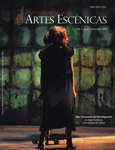Authors
Abstract
The present article presents a hermeneutic exercise on the William Shakespeare’s play Romeo and Juliet (1595). As a theoretical reflection, the article will contribute to the corpus of the creative process of the Verona performance, which is being prepared by students of the Drama Arts Department at the Universidad de Caldas. In order to achieve this important objective it’s important to acknowledge that, as expressed by Gadamer, “the play presents an untemporal present” (2001: 55), which makes possible the reading of the play itself in the present time (Ibíd.); in other words, in the here and now of the reader, or in this case, of the receptorcreator, role corresponding to the theatrical director. The article includes the conversation between some parts of the play and the author’s understanding.
References
Bergua, J. (1972). Comedias de William Shakespeare. Compendio. Madrid: Ediciones Ibéricas. Notas preliminares, pp. 5-28.
Boal, A. (1974). Teatro del Oprimido y otras poéticas políticas. Buenos Aires: Ediciones de la Flor. pp. 14-50.
Fromm, E. (1993). El arte de amar. Una investigación sobre la naturaleza del amor. Barcelona: Paidós.
Gadamer, H. (2001). Estética y hermenéutica.Traducción de Antonio Gómez Ramos. Madrid: ed. Tecnos.
________. (2002). Hermenéutica de la Modernidad. Conversaciones con Silvio Vietta.Traducción de Luciano Elizaincín-Arrarás.Madrid: ed. Trotta. p. 11.
Iriarte, A. (1996). Lo teatral en la obra de Shakespeare. Bogotá: Ediciones Uniandes.
Kartum, M. (1998). “Poner un mundo a vivir: El oficio del escritor”. En Revista Gestus, Número Especial abril: 6-20.
Kott, J. (2006). “Es todavía Shakespeare nuestro contemporáneo?”. En Revista El Malpensante, 69: 46-49.
Macgowan, K. Melnitz, W. (2004). Las edades de oro del teatro. México: Fondo de Cultura Económica. pp. 121-190.
Maturana, H. y Bloch, S. (1996). Biología del emocionar y Alba Emoting. Santiago de Chile: Dolmen ediciones. pp. 19-20.
Shakespeare, W. Comedias. Traducción de Juan Verruga.
Stanislavsi, K. (1994). Ética y disciplina. Método de las acciones físicas. Traducción de Margherita Pavia. México: Grupo Editorial Planeta.

 PDF (Español)
PDF (Español)
 FLIP
FLIP









